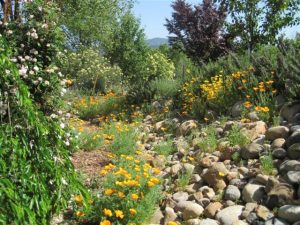The view from my kitchen window was really ugly for years: a very steep, rocky slope that, I admit, I left to the weeds for too long. I didn’t have the money or energy to consider terracing or erecting a solid fence. And until I learned otherwise, I assumed that a hot, dry hillside was just too harsh an environment to plant anything I’d want to look at as I washed dishes.
Slopes are definitely challenging, garden-wise. Watering and drainage are problematic, not to mention access in general, for plants that need deadheading or any other routine maintenance. Fortunately, I learned in time that there are scads of low-maintenance, drought-tolerant plants that can cover a hillside with attractive foliage and flowers. They also provide the added benefit of preventing soil erosion, which is a very good thing if the hillside is just ten feet from the back of your house (like mine).
The following are either western native, or drought-tolerant, low-growing plants that make light work of routine gardening on slopes. Most grow from six to 12 inches tall, but a few can reach 24 inches. Most can take direct sun, but a few look their best with a little afternoon shade. The list is loosely organized by virtue.
No-water wonders: These three top my list for low-maintenance plants that are happy on a hot, dry hillside: creeping California lilac (Ceanothus), with smoky purple flowers the bees love; creeping manzanita (Arctostaphylos uva-ursi), with tiny, bell-shaped pink flowers and red fruit; and prostrate rosemary, with pale blue blooms and scented foliage. All three bloom in spring, and once established, require zero supplemental water. The only downside is that these plants are relatively slow growing, so if you want to cover a slope in a hurry, choose from other plants mentioned below.
Fast coverage: Native dwarf coyote brush (Baccharis pilularis) is one of the fastest-growing, toughest groundcovers around. Low-growing wall germander (Teucrium chamaedrys) sports small, glossy, dark green leaves and teensy lilac flowers. Creeping St. John’s Wort (Hypericum calycinum) will easily cover a problematic slope, and its fairy-like yellow flowers are lovely; but it can be invasive, so site it with that in mind. St. John’s Wort is one of those hardy groundcovers that look better if it receives some afternoon shade.
Dazzling flowers: Most of the plants mentioned above have lovely blooms, but there is nothing like the car-stopping appeal of a carpet of pink-flowering, creeping thyme. Rockrose (Cistus) is a small, mounding bush that is covered with pink or white crepe-paper-like flowers in spring and summer, and probably wins the prize for a plant that thrives on neglect.
Interesting texture: If you like a more rock garden/desert look, there is a mind-boggling selection of succulent Sedums, many of which flower in late summer or fall. “Angelina” and “Dragon’s Blood” are two favorites. Creeping junipers can provide dramatic, almost sculptural texture, as well as being evergreen. Artemesia californica “Canyon Gray” is a low-growing, native sagebrush that has feathery gray foliage and is a nice companion to the pink-flowering rockrose.
There are many more options for slopes and hillsides than you might think, so don’t give up on them too quickly. Here are some resources for finding more suitable plants: University of California’s “The California Garden Web” at http://cagardenweb.ucanr.edu/. The local chapter of the California Native Plant Society at www.sierrafoothillscnps.org.
Rachel Oppedahl is a University of California Cooperative Extension Master Gardener of Tuolumne County.
UCCE Master Gardeners of Tuolumne County can answer home gardening questions. Call 209-533-5912 or go to: http://ucanr.edu/survey/survey.cfm?surveynumber=7269 to fill out our easy-to-use problem questionnaire. Check out our website at: http://cecentralsierra.ucanr.edu/Master_Gardeners/ You can also find us on Facebook



